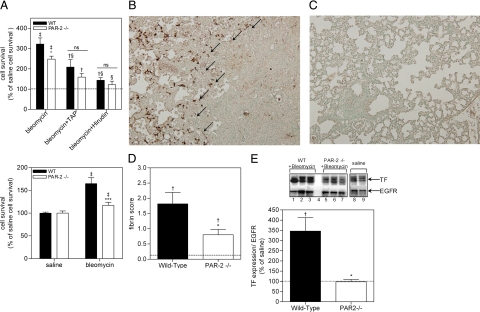Figure 6.
PAR-2 deficiency attenuates coagulation-dependent BALF-induced fibroblast survival, pulmonary fibrin deposition, and TF expression. A (top): Survival of murine fibroblasts induced (for 24 hours) by BALF of wild-type or PAR-2−/− mice treated for 14 days with bleomycin, in the presence or absence of TAP or hirudin. The results are shown as mean ± SEM of percentage survival induced by BALF of saline treated mice (dotted line). Bottom: Survival of murine lung fibroblasts isolated from wild-type or PAR-2 −/− mice induced (for 24 hours) by BALF of wild-type mice treated for 14 days with bleomycin. Shown are the mean ± SEM. †P < 0.05 and ‡P < 0.005 for BALF of bleomycin versus saline treated mice. *P < 0.05 for BALF of bleomycin treated wild-type versus PAR-2−/− mice. §P < 0.05 for BALF of bleomycin-treated mice without TAP or hirudin versus BALF of bleomycin treated mice with TAP or hirudin. ns, no significant differences. B and C: Representative pictures of immunological staining of fibrin deposits (brown regions, arrows) in wild-type (B) and PAR-2−/− mice (C) 14 days after bleomycin instillation. D: Semiquantitative scoring of fibrin deposition in wild-type (n = 6) and PAR-2−/− (n = 7) animals 14 days after bleomycin instillation. E, top: Western blot analysis of TF expression in wild-type (lanes 1–3) and PAR-2−/− mice (lanes 5–7) 14 days after bleomycin or saline (wild-type, lane 8; PAR-2−/−, lane 9) treatment. Lane 4, marker. Epidermal growth factor receptor serves as a loading control. E, bottom: Quantification of TF expression in the lung of wild-type or PAR-2−/− animals 14 days after bleomycin instillation. Shown are the mean ± SEM of n = 4 mice per group. A, D, and E: The dotted lines represent the mean expression in saline-treated mice. †P < 0.05 and ‡P < 0.005 for bleomycin versus saline treated mice. *P < 0.05 and ***P < 0.005 for bleomycin treated wild-type versus PAR-2−/− mice. ns, non significant.

